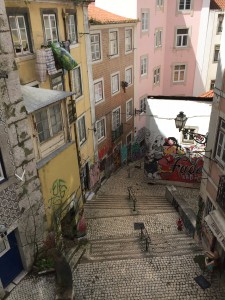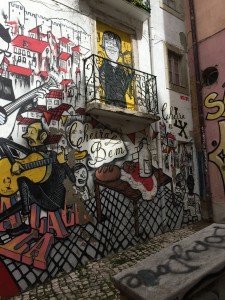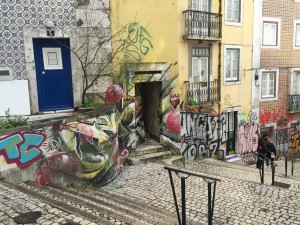A Tour of the Mural Escadinhas São Cristóvão
 In the heart of Lisbon, on the walls of age-old buildings lining a long set of stairs that lead from R. da Madalena to the Church of São Cristóvão, vivid graffiti complements an equally-vivid mural. The mural honors St. Christopher and the musical tradition, Fado. Part of Lisbon’s rich history, Fado is performed throughout the city in small bars and taverns. In Fado, men and women sing soulful songs, often about poverty, frequently accompanied by acoustic and Portuguese guitars.
In the heart of Lisbon, on the walls of age-old buildings lining a long set of stairs that lead from R. da Madalena to the Church of São Cristóvão, vivid graffiti complements an equally-vivid mural. The mural honors St. Christopher and the musical tradition, Fado. Part of Lisbon’s rich history, Fado is performed throughout the city in small bars and taverns. In Fado, men and women sing soulful songs, often about poverty, frequently accompanied by acoustic and Portuguese guitars.
The mural is located at Escadinhas de São Cristóvão (steps to St. Christopher) in the Mouraria neighborhood of Lisbon, thought to be the birthplace of Fado. The conglomeration of color found there gives one the sensation of actually standing inside a work of art.
How the Mural Escadinhas São Cristóvão Began
In 2012, a group of parishioners, led by MASC – (Friends of St. Christopher Movement), teamed up with local artists and residents to beautify the neighborhood by painting a mural depicting both the Fado tradition and honoring St. Christopher.
 The mural starts in a narrow stairway just off R. da Madalena at Escadinhas de São Cristóvão. On the left side of the steps is the mural. On the right is graffiti. The mural itself begins with a water scene, the Tagus River, which runs, for more than 600 miles, through Portugal and terminates in Lisbon.
The mural starts in a narrow stairway just off R. da Madalena at Escadinhas de São Cristóvão. On the left side of the steps is the mural. On the right is graffiti. The mural itself begins with a water scene, the Tagus River, which runs, for more than 600 miles, through Portugal and terminates in Lisbon.
Fado Song Illustrated
The first scene depicts a wooden coffin floating in brilliant, blue choppy waves with a red-tipped axe floating above. The words accompanying the image, “Talhas com o teu as do meu,” according to a MASC Facebook post, translate to “Hoist with your axe the boards of my coffin.” This is a reference to a Fado song, “Povo que lavas no rio,” which reflects the soul of Portugal and trials of economic hardship. At the right of the scene is the image of a balding man with pink-tipped nose, and a mustache, wearing a blue-and-white checkered shirt, who is casually raising a stemmed glass filled with a red liquid, presumably wine. A comment on the Facebook post, asking the identity of the man, is unanswered.
St. Chrisopher Carries the World
Further up the steps, the river theme continues with a scene that includes a Cleopatra-style Egyptian siren, mythological half-woman, half fish, the likes of which lured many sailors to their deaths. Red-tile roof stucco buildings perch on hills in the background. This scene includes the image of a worried-looking St. Christopher crossing the river while carrying the baby Jesus and the weight of the world on his back. St. Christopher’s skin is painted yellow, and he is clad in red robes with his long, thin legs stepping through the waves, while a contented Jesus hugs the globe.
St. Christopher heads toward two portly old women, clad in black dresses, who appear to be whispering to each other. Crowns hover above each of their heads, while one of the women pets a pink cat, surrounded by a yellow scroll, and the other clutches her knitting. The women might be a representation of one of the interpretations of the Fado song, Povo que lavas no rio, mentioned earlier, with the axe representing the women’s gossiping tongues. At this point, the narrow stairway opens to a larger area with three walls of mural and more graffiti on the buildings facing them.
Fado Vadio Comes to Life
 This section of the mural is dedicated to Fado, and its focal point is the image of a buxom, raven-haired beauty. She wears large hoop earrings and a low-cut, bold-yellow blouse. A cigarette is pressed between her full, red lips, while her fingertips dip into the cocktail she holds in her hand. Her short red skirt, with a daring slit, exposes an ample, fishnet-stocking-clad leg. Beneath the image is the name, Maria Severa. Severa is considered to be the first-ever Fado singer to achieve fame, and after death in 1846, she became a Lisbon legend.
This section of the mural is dedicated to Fado, and its focal point is the image of a buxom, raven-haired beauty. She wears large hoop earrings and a low-cut, bold-yellow blouse. A cigarette is pressed between her full, red lips, while her fingertips dip into the cocktail she holds in her hand. Her short red skirt, with a daring slit, exposes an ample, fishnet-stocking-clad leg. Beneath the image is the name, Maria Severa. Severa is considered to be the first-ever Fado singer to achieve fame, and after death in 1846, she became a Lisbon legend.
Vividly painted Maria Severa rests on the words “Fado Vadio” and she slings an arm around the black-and-white image of a thin, bald, mustachioed man, who wears a striped polo shirt and holds a microphone to his mouth. To the left of the man with the microphone is another man, also as a black-and-white image, sporting an ample head of hair, thick eyebrows, and a horseshoe mustache. This man wears a suit under which his unbuttoned shirt reveals a cross necklace and a bit of chest hair. Musical notes flank the man’s neck, which features a prominent Adam’s apple, and lines array outward from his entire image. Beneath his image is the name Fernando Maurício, a 20th-century “Fadista,” who became a recording star and appeared on radio and TV, before his death in 2003.
The three images described above, along with that of a rather large black bird, are placed in the foreground of a hilly jumble of white stucco, red-tile-roofed houses, some with balconies, over which a tiny helicopter hovers. Several fish, one on a plate, are depicted here as well. In a physical window of the structure, a black-and-white image of a person peers out onto the square.
A Woman Observes the Entertainment From Her Balcony
 On the next wall attached from a 90-degree corner, the mural depicts another hillside with tiered buildings, and at the top, the sixth-century St. George’s castle, which can be seen from just about anywhere in Lisbon. In the foreground, one man plays a Portuguese guitar and another plays a standard acoustic guitar. On the body of the acoustic guitar is what appears to be the pop-art headshot of 1960s super-model, Twiggy, with the words “alma feminina” (female soul) inscribed below it. That guitarist sits on a mass of letters spelling “La, La, La, La.” The images of four other men are present as well, including one who appears to be of African descent, sporting a funky cap and sunglasses.
On the next wall attached from a 90-degree corner, the mural depicts another hillside with tiered buildings, and at the top, the sixth-century St. George’s castle, which can be seen from just about anywhere in Lisbon. In the foreground, one man plays a Portuguese guitar and another plays a standard acoustic guitar. On the body of the acoustic guitar is what appears to be the pop-art headshot of 1960s super-model, Twiggy, with the words “alma feminina” (female soul) inscribed below it. That guitarist sits on a mass of letters spelling “La, La, La, La.” The images of four other men are present as well, including one who appears to be of African descent, sporting a funky cap and sunglasses.
Continuing rightward, there is an actual door in the building behind the wrought-iron railing of a false balcony. The doorway is plugged by masonry, and on it is painted the black-and-white image of a woman, with a rabbit-eared television in the background. The television screen features an image of a monster with jagged teeth. The woman wears rectangular glasses, a helmet-shaped hairstyle, a pearl necklace, and a black dress complemented by a lace shawl. She is smiling, and her hands grip either side of the doorway.
Smells Good, Smells Like Lisbon
Below the woman on the balcony is a picture of a table, with a white-lace-trimmed red cloth, on which are set two loaves of bread and a stone jug that contains the word, “Vin,” (wine) and a grape-bunch drawing. Next to these items are painted the scrolling words, “Cheira Bem,” which means, “smells good.” On the other side of the window, near the corner of the wall and end of the mural, the words “Cheira a LX,” appear above additional images of a stucco building and several people, including a man with dark skin and what looks to be the word, “Cachura” written across his shirt.
Taken together, the words Cheira Bem and Cheira a LX, refer to a song, which translated means, “Smells good, smells like Lisbon.” LX is the acronym, which is often used for Lisbon, Portugal. The song, “Cheira Bem, Cheira a Lisboa,” was made famous by Amália Rodrigues, who died in 1999 and is known as the mother of Fado. She is referred to as the best-selling Portuguese artist of all time.
The adjacent wall holds the final section of the mural, which contains the large lettering “São Cristo,” and the image of a Catholic priest. This is the representation of the contemporary pastor of the Church of St. Christopher, Edgar Clara, who posed for a photo with his likeness.
Cohabitation of Commissioned Mural and Impromptu Graffiti
 Now that the mural has been described, it is time to address the graffiti. In fact, graffiti existed in this area before the mural project began. The mural itself was painted over graffiti. Interestingly, a comparison of photos of when the mural was first being painted to present reveals an explosion of new graffiti in the area, but very little of it defaces the mural. Instead, it complements it. The graffiti is a potpourri of color in symbols, faces, and letters, which could be well described and interpreted by a local, because there seems to be a great deal of cultural meaning contained within it.
Now that the mural has been described, it is time to address the graffiti. In fact, graffiti existed in this area before the mural project began. The mural itself was painted over graffiti. Interestingly, a comparison of photos of when the mural was first being painted to present reveals an explosion of new graffiti in the area, but very little of it defaces the mural. Instead, it complements it. The graffiti is a potpourri of color in symbols, faces, and letters, which could be well described and interpreted by a local, because there seems to be a great deal of cultural meaning contained within it.
If you ever find yourself in Lisbon, it will be well worth it to reserve some time to visit this interesting display of culture and cohabitation of conventional art with urban expression. For more photos and information, visit the Movimento os Amigos de São Cristóvão Facebook page.
More Portugal Posts:
Portuguese Mural Triggers an Amazing Race
Seven Basic Facts About Portugal
7 Things US Visitors to Portugal Should Know
7 Expressions to Know in Portugal
7 Things You Must Know When Visiting Portugal
Ann Silverthorn writes about a wide variety of topics in numerous genres. She recently completed a biography of William E. Dimorier (1871-1951), a forgotten poet and educator, who dedicated his life to service and leadership and is pursuing publication. Several new projects are underway.
Facebook: www.facebook.com/AnnSilverthorn
Twitter: @annsilverthorn
Instagram: ann_silverthorn




Leave a Reply